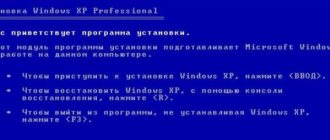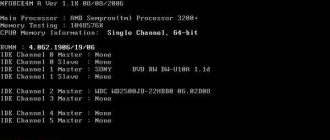One client says: after updating Windows 10, the screen began to flicker and programs would not start. I arrive at the address and find out that the conductor is not working correctly. The Windows 10 restore point using the command line helped fix the situation.
I remember another incident on my computer. I accidentally deleted the program I needed and only noticed it the next day. It’s good that before deleting, a Windows 10 restore point was created. This helped to return the program with all the settings as they were.
In this article, I will show in detail how to enable recovery, how to create a point, how to run Windows 10 recovery and how to delete unnecessary recovery points in several ways.
How to enable a restore point
By default, System Restore is disabled in Windows 10. To enable, you need to do the following:
- Click on the folder in the taskbar (see screenshot below).
- Place the cursor on This PC and right-click.
- Select properties from the menu.
Go to system properties of Windows 10.
In the window that opens, go to - System protection .
Let's go to Windows 10 system protection
A window opens - System Protection , where you can enable System Restore, create a restore point and start the restore.
To enable System Restore:
- Click the configure button.
- We put the switch on - Enable system protection .
- Move the slider by 5-10 percent. I usually allocate 5-10 GB for system recovery, this is enough.
Enable Windows 10 recovery
After these steps, you will be able to create system restore points.
For which disks there are recovery points.
In fact, the system allows you to configure recovery points for all disks. And through the window that you were able to successfully open earlier called “system properties” you can easily find out, check and even configure the disk and its recovery point.
If the disk has protection enabled, then the recovery point is also subject to it. If the protection is not enabled, you can disable it with simple steps directly in this menu. Just select the drive and “turn on system protection”. Then a request where you need to indicate the amount of space. And here a clear pattern will be traced: the more places you choose, the more points you can naturally create. And when the memory is full, the first point will be deleted and a new one will be formed.
How to create a Windows 10 restore point
To create a restore point, write in the Windows 10 search, near the start button:
- Creating a point (see screenshot below).
- Click - Create a restore point .
Go to create a Windows 10 restore point
Next click:
- Create button.
- We enter the name of the point, I usually put a number.
- Click the create button.
Creating a restore point in Windows 10
Windows 10 has created a restore point
Why is it important
If errors occur in Windows that can be eliminated by performing a certain sequence of actions, such as with an error in launching VBScript scripts, then there are no problems - we remove the cause of the “glitch” and continue to use the system! But it also happens that it is impossible to return “everything to its place”, to bring Windows back to life, it’s a dead end. So what should we do - a complete reinstallation of the entire system and all necessary programs? Not a very good, long and tedious option.
With this scenario, there are few options for action - after all, if you are not an experienced Windows user who understands its structure, understands all the nuances of the operation of certain Windows system functions, then in the event of a global failure and incorrect operation of the operating system, you will have practically only one option - complete reinstalling Windows 10, from scratch!
At the same time, you will have to install all the software that you are used to working with. In some cases, it is even possible to lose data on the disk - photos and video files, some databases that you previously worked with, and any other types of files and file information.
Based on this, it becomes clear that creating such a “saving” point in Windows 10 will be an excellent, time-saving and understandable tool for you, always at hand, which will quickly and painlessly return the system to working order. In addition to the fact that all operating system files (file system) will be rolled back, the Windows registry and the software responsible for the operation of PC components - device drivers - will also be restored.
Thus, there is practically no more comprehensive and speedy option for bringing Windows 10 to life, and the alternative in the form of a complete reinstallation of Windows is not convenient, because You will spend much more time on this, and in some cases you will lose your accumulated information located in a system that suddenly stopped working.
Let's study in detail how you can create restore points. And also how, if such a need arises, you can restore your “OS” using the same pre-prepared points of return to the working form of Windows.
How to run Windows 10 System Restore
To start recovery and roll back the system, I will show 2 methods, where the paths are different, but the principle is the same.
Method 1: Through Windows 10 settings
- In the lower right corner near the clock and date, click on the notification icon.
- Go to - All parameters .
Or instead, press Win+I to open All Settings .
Opening Windows 10 settings
In the search field, enter - recovery and select from the list as shown in the image below.
Looking for recovery in Windows 10 settings
Next, select - Start System Restore .
In the Windows 10 Control Panel, select Run System Restore
Restore system files and settings will open. Here you can select the recommended recovery.
I always select a different restore point to see a list of all restore points.
Selecting a different restore point in Windows 10
Next, select one of the points, focusing on the date when it was created. For example, if we know that on December 9, 2021 everything worked well, then we select this point and click next.
Restoring Windows 10 to its previous state
After system recovery starts, the computer will reboot, all that remains is to wait for Windows 10 recovery to complete.
Method 2. Through Windows 10 system protection
Near the start button, in the Windows 10 search field, enter - create a dot . In the list that appears, select creating a restore point.
Let's go to create a Windows 10 restore point
A window will open on the tab - System Protection .
Click the button - Restore .
Click the restore button to restore the system
We also select another restore point, as in the first method.
Selecting a different restore point in Windows 10
Select the desired restore point and click Next to start restoring Windows 10.
Restoring Windows 10 to its previous state
Method 3: If Windows 10 won't boot
If the system does not boot, then you cannot use the first two methods. To do this, there is another way to restore the system - using Windows 10 diagnostic tools.
When you boot Windows 10, automatic repair should start. Open advanced options as shown in the photo below.
If automatic recovery does not start, then during system boot, forcefully turn off the computer with the button and turn it on again. Do this 2 times, the third time the automatic recovery will start.
Opening advanced settings in Windows 10
- Select the section - Troubleshooting .
- Open - Additional options .
- Let's go - System Restore .
- Select your account.
- Enter the account password or leave the field blank if there is no password.
We start Windows 10 system recovery.
Next, the process occurs in the same way as described in the first two methods. Select a restore point and wait for the process to complete.
If you have any difficulties or questions, write to me in the VK group - https://vk.com/ruslankomp
I will help you solve a problem with your PC or laptop. Join the VK group - ruslankomp
Creating a full system image
Windows 10 has one good backup option - creating an image of the entire system on a separate disk or DVD (you will need several, in my opinion it is better to use an external hard drive, or a second disk - if you have 2+ of them in the system).
The difference between this method and classic restore points is that this method creates a complete archive with all programs, drivers, user files, settings, shortcuts, etc. that are on the system.
Note. It makes sense to create such an image when you have everything set up and everything works well. Typically, this time comes after 2-3 days after installing Windows.
Creating an image
1) First, open the control panel, then the “System and Security” section, then “Backup and Restore” (an example is shown in the screenshot below).
System and Security - Backup
2) Next, in the menu on the left, you need to click the “Create a system image” link.
Creating a system image
3) Now you need to specify the media on which the image will be saved. Usually, they choose an external hard drive (or a “large” flash drive of 64 GB, 128 GB, for example).
Where will the archive with the system be stored?
4) Here you need to indicate which disks you want to archive. Windows, by default, includes the disk on which it is installed and several system partitions. If this is not enough for you, you can include other local drives.
Note. Pay attention to the space that will be needed for archiving. Windows will show you the free space on your media and the required backup space. If you select several more local drives, the required space for archiving will increase in proportion to the selected drives.
Selecting disks to be archived
Using an image. When you start having “problems” with Windows 10, you can quickly and easily roll it back completely to its previous state using this image. To start recovery from such an image, there are 2 ways:
- - use a recovery disk;
- — in the Windows setup program, select: Diagnostics/Advanced options/System image recovery.
Addition . By the way, you can make a complete cloning of a hard drive using third-party programs (many of them, frankly speaking, have many more options and are more convenient to use than standard Windows tools). For example, such programs are: Acronis True Image, EASEUS Disk Copy, Paragon Drive Backup Personal, etc.
Restore Windows 10 system via command line
To run System Restore via the command line:
- Press Win+R and enter cmd to launch the command line
- To start system recovery, enter - rstrui.exe .
Next, follow the same steps as described in the previous section on system recovery - method 1 or method 2.
Running System Restore using the rstrui.exe command
You can run System Restore directly in the field without opening the command line. Press Win+R and enter rstrui.exe
Open System Restore using rstrui.exe
How long does it take to restore a Windows 10 system?
I have had cases where system recovery took about 60 minutes. Sometimes there was even a desire to turn off the computer and turn it on again, but here you need to be patient. If more than two hours have passed and no changes occur, then the recovery is most likely frozen.
The total amount of time to restore Windows is made up of:
- initializing system recovery;
- file and registry recovery;
- deleting temporary files.
This takes approximately 20-30 minutes. It may take another 10-15 minutes to complete the restore, where additional system settings are performed.
Windows 10 recovery process
Windows 10 recovery time depends on several factors:
- Computer performance.
- Depending on the degree of damage to the system.
Computer performance consists of:
- processor power (the more cores and the higher the frequency, the better);
- amount of RAM, the more the better;
- SSD or HDD drive.
If the system is installed on an SSD, then restoring Windows 10 will be much faster than on a regular HDD.
Goldenfir SSD drive
If you want to increase the performance of your computer or laptop, you can purchase an SSD drive at a good price.
For example, on a computer with a 6-core processor, 16 GB RAM and an SSD drive, Windows recovery will be faster than on a laptop with a 2-core processor, 2 GB RAM and a regular hard drive.
Also, the duration of recovery depends on the degree of damage to the system. There is no point in waiting more than 1.5-2 hours. Most likely, system recovery will not be successful. One reason could be a faulty hard drive.
If you have problems with system recovery, please contact here - vk.com/ruslankomp
I will help you solve a problem with your PC or laptop. Join the VK group - ruslankomp
It’s also worth considering that if you roll back to a restore point created 3-6 months ago, it may take longer than rolling back a day or week ago.
Where to find a windows 10 restore point
Windows 10 restore points are located in a hidden System Volume Information in the root directory.
To see the System Volume Information , I use Total Commander. But you can also see this folder in regular Windows 10 Explorer.
To do this, go to - This computer, where the disks are displayed. Open drive C, where Windows 10 is installed and then go through the steps, as shown below:
- Go to the section - View .
- Click on the icon - Settings .
- In the window that opens, go to the tab - View .
- Uncheck the box - Hide protected system files .
- Set the switch to Show hidden files, folders and drives .
- Click apply.
Setting up the display of hidden Windows 10 system files
After this procedure, we will see the very hidden System Volume Information folder where Windows 10 restore points are stored.
Windows restore points are stored in a hidden System Volume Information folder
But the system will not allow us into the System Volume Information folder, since we do not have enough rights.
In this way, the system is protected from inexperienced user actions. I don’t know for what purpose I need to go into this folder.
If you need to find a restore point to roll back the system, then this is already described in the section - how to restore a Windows 10 system.
If you need to delete unnecessary restore points, then read the next section.
How to delete a restore point in Windows 10 - 3 ways
Method 1: Delete all restore points
Enter the command in the search field on the Windows 10 taskbar - systempropertiesprotection
Select from the list - systempropertiesprotection execute command
Enter the command in the search field and press Enter
Next we do as shown in the figure below:
- Click the configure button.
- Click the Delete button.
- Continue.
This method deletes all restore points without exception.
Delete all Windows 10 restore points
Method 2: Delete all points except the last one
Press the key combination Win+R :
- Enter the command - cleanmgr
- Press Enter or click OK.
- Select the system drive and click OK.
We enter the command to delete restore points, except for the last one.
Next, open the tab - additionally.
- Click clear.
- And delete.
All restore points except the most recent one will be deleted.
Deleting a restore point except the last one
Method 3: Deleting restore points using CCleaner
Using CCleaner, you can delete unnecessary restore points one by one.
For convenience, I have posted all the programs in the category - Programs. There you can also find a link to download the CCleaner program.
So let's launch CCleaner. Open tools - system recovery. Select an unnecessary recovery point from the list and delete it.
Delete restore points one at a time using CCleaner
How to restore Windows 10 if there is no restore point
If there are no restore points on the computer, then you won’t be able to roll back to the desired date when the system worked without errors.
There are no restore points on the Windows 10 system drive
In this case, restoring the system to its original state may help. To do this, open system settings using the Win+I .
Open update and security - recovery .
Open Update and Security in Windows 10 Settings
To start the rollback, click - Start .
Restoring Windows 10 to its original state
A window for selecting the return to original files mode will appear. There are two options:
- Save my files. All applications and settings will be deleted, but personal files will remain.
- Delete everything. All information will be erased from your hard drive, including your personal files, applications and settings.
Selecting the option to restore Windows 10 to factory settings
After starting the reset, the computer will reboot. Your participation will no longer be required, since the machine will perform all the necessary actions on its own. After the reset is successfully completed, you will receive a new system without unnecessary programs and settings.
How to roll back the system to a few days ago?
How to perform a system rollback
- Click “Start” - “All Programs” - “Accessories” - “System Tools” - “System Restore”;
- In the window that opens, select “Restore the computer to an earlier state”...
- In the left window, select the date of the control point.
1 Jan
2016 Interesting materials:
What does limited access mean on Instagram? What does error 0xc000007b mean when starting the game? What does error 23 mean on the radio? What does error 38 mts mean? What does error 400 mean in Youtube? What does error 429 mean on YouTube? What does the application startup error 0xc000007b mean? What does error 0xc0000142 mean when starting an application? What does it mean on behalf and at the expense of the principal? What does a canceled report mean?











